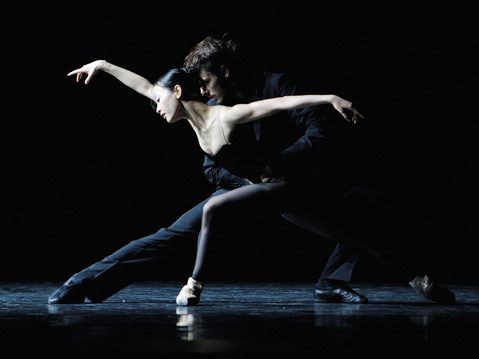La La La Human Steps to Perform New Work
Édouard Lock Brings Latest Dance to the Granada on January 28

Plenty of choreographers have set dances to Gluck’s Orpheus and Eurydice and Purcell’s Dido and Aeneas, two baroque operas whose storylines center on star-crossed lovers. But nobody has taken these tales or their scores further into the territory of abstraction than Édouard Lock. Lock’s Montreal-based company La La La Human Steps was last in Santa Barbara in 2008 to perform Amjad, his deconstructed take on Sleeping Beauty and Swan Lake. Now, he’s back with New Work, his latest collaboration with contemporary composer Gavin Bryars, and a ballet that defies audience expectations as much as it pushes its performers. Expect a minimalist set and score, tricky lighting, a twitching gestural vocabulary, and ballet technique pushed to its extremes. Last week, Lock took a moment to talk about his latest choreographic challenge.
Why did you pick these two operas? I think it’s always interesting to have an audience come in with preconceived notions and personal associations. These scores and the storylines of these operas have integrated themselves into our cultural memory, even if you’ve never seen them.
Tell me about the relationship in New Work between the music and the dance. There never has been a very strong relationship in my work between the score and the choreography. The two really evolve separately. The choreography has its own structure and its own rhythms. Certainly no one would think of asking a composer how he could write music without a dancer present, and the inverse should be true.
One of the things that struck me most about Amjad was your use of light to obscure as much as to illuminate the dancers. Can you talk a little about light in New Work? Yes. The idea of light exposing or presenting what’s onstage in a clearly viewable fashion is rather passive. I think it’s much more interesting when light does what’s more counterintuitive, which is to hide rather than expose. When I was a kid, my father would do these drawings, and then he’d start adding shadows. I’d ask him why he was covering up what he had drawn, and he’d say, “That’s the part that’s interesting.” We’re inherently built to deal with an environment that doesn’t always cooperate with us. When we want to see something, we have to filter out the things we don’t want to see. I like to use light to create an unstable environment.
It sounds like you’re thinking almost cinematically. How do you balance the visual and the kinesthetic in your choreography? Again, I think the two are separate. What makes choreography interesting is the structure, not the meaning. I think it’s a mistake to have the structure itself carry the narrative, because it oversimplifies it. You know, when you first have an idea, you don’t even know what it means. As you try to articulate your idea, it’s hard not to simplify it further and further and further until it has no relationship to the initial idea. Choreography can get into trouble if it tries to tell a story too early in the process.
What kind of risks do your dancers have to take in order to perform this kind of work? There should be a risk in just stepping onto stage, and I don’t mean a physical risk; I mean an ego risk. The members of an audience have already failed on that day, that week, that month, so they have a sense of being tied to a situation that involves failure. What happens on the stage should also invite failure, or else you risk the inverse, where the stage is charismatic, and it’s all about the audience admiring the dancer. In that case, there’s no empathetic bridge between the audience’s world and the stage world. So I ask the dancers to take technical risks, to go to the edge. That way, the work erodes over time. That isn’t necessarily possible in the studio, but as soon as you are observed, you’re handed the tools to get rid of what isn’t necessary. It’s a generous thing to do, because I don’t know of any performer who doesn’t want to look perfect onstage.
4•1•1
La La La Human Steps will perform Édouard Lock’s New Work at the Granada Theatre (1214 State St.) on Saturday, January 28, at 8 p.m. For tickets, call 893-3535 or visit artsandlectures.sa.ucsb.edu.



